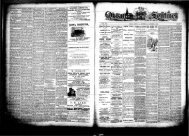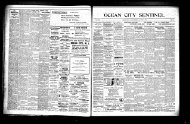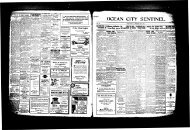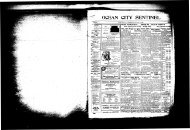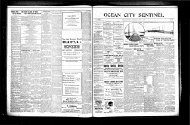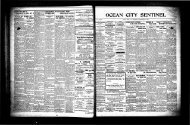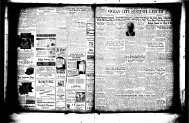Apr 1993 - On-Line Newspaper Archives of Ocean City
Apr 1993 - On-Line Newspaper Archives of Ocean City
Apr 1993 - On-Line Newspaper Archives of Ocean City
Create successful ePaper yourself
Turn your PDF publications into a flip-book with our unique Google optimized e-Paper software.
' ' ' ' • . '<br />
• • • ; ; •<br />
C4 THES£rmN£L-lEDQ£ft bo—n <strong>City</strong>, IU. Thurwtoy. <strong>Apr</strong>il 15.<strong>1993</strong><br />
Besses man, there are other<br />
Thursday, <strong>Apr</strong>il 1S.1M3 OoMHlCtty,»U.<br />
THE SENTINEL-LEDGER C5<br />
BWGANTDME — Look...<br />
.but in the water! It's a<br />
shark! It's a porpoise! No,<br />
it's a dolphin. •<br />
"'.,.'•' ' DOLPHINS<br />
Look put over the ocean<br />
almost any summer day in<br />
New Jersey, and you .will<br />
probably see dolphins<br />
svy-3uning along the beach.<br />
Bottlenose -<br />
- Those large, curved, gray<br />
•dorsal fins going up and<br />
down belong to the Atlantic<br />
bottlenose dolphin, our<br />
most well-known dolphin.<br />
The bottlenoee is the only<br />
dolphin that normally<br />
swims dose to die shore in<br />
New Jersey. They also give,<br />
. birth in our waters, and we<br />
can see the baby dolphins<br />
swimming along dose to<br />
their mothers.<br />
Bottlenose dolphins live<br />
in all oceans with warm<br />
waters. About 3 feet long at<br />
birth, they grow up to 10<br />
jeet long as adults. They are<br />
usually light gray on the<br />
. ventral (stomach) side and<br />
darker gray on the rest <strong>of</strong><br />
their body. '<br />
During the summer; bottlenose<br />
dolphins migrate a>.<br />
far north as Cape tod. They"<br />
come north to feed'on many<br />
kinds <strong>of</strong> fish including bluefish,<br />
mackerel;" 'menhaden;<br />
thejfcuso eat squid.<br />
••- Common<br />
Common dolphins are<br />
one <strong>of</strong> the <strong>of</strong>fshore species<br />
in New Jersey waters. They<br />
are black on the dorsal<br />
(back) side, white on the<br />
ventral side, and have an<br />
hourglass figure on their<br />
sides that is tan in front and<br />
gray in back. Common dolphins<br />
grow to about 8 feet.<br />
Striped<br />
Striped dolphins are<br />
another <strong>of</strong>fshore species.<br />
They are black on the dorsal<br />
side and white on the ventral<br />
side. As their name suggests,<br />
they have a<br />
distinctive stripe that<br />
begins in front <strong>of</strong> the-eye<br />
and runs to the ventral sift<br />
CITY OF SEA ISLE CITY, CAPE HAY COUNTY, NEW JERSEY<br />
NOTICE<br />
TO MILITARY SERVICE VOTERS AND<br />
TO THEIR RELATIVES AND FRIENDS<br />
If you are In the miftary service or he spouse or dependent <strong>of</strong><br />
a person In mNtary service or are a patient In a veterans' hospital<br />
or a cMttan attached toor serving with Ihe Armed Forces oHhe<br />
United StatM without the State c4 New Jersey, or the spouse or<br />
dependant <strong>of</strong> and accompanying or residing with a civilian<br />
attached to or serving witfi the Armed Forces <strong>of</strong> the United<br />
Stales, and desire to vote, or H you are a relative or friend <strong>of</strong> any<br />
such person who, you believe, will desire tovote in the Municipal<br />
Section to be heid on June 8; <strong>1993</strong>. kindly write to the<br />
undersigned at once making, application for a military service<br />
baUot tobe voted hi saM election tobe forwarded toyou, stating<br />
your name, age. serial number rlyou are In military service, home<br />
address and tfw address at which you are stationed or can be<br />
found, or if you desire the miltary service ballot for a relative or<br />
friend then make an application under oath for a mBitary service<br />
baHot to btt<strong>of</strong>wardedto him. stating toyour appBcabortthat he<br />
Is over the_age <strong>of</strong> 18 years and stating his name, serial number<br />
tthajs In the miMaiy •ervtea.hjjTje address and (he address at<br />
(NOTE: MILITARY SERVICE VOTER CLAIMING MILITARY<br />
STATION AS HOME ADDRESS FOR VOTING PURPOSES MAY<br />
NOT USE MILITARY ABSENTEE BALLOT UNLESS<br />
REGISTERED TO VOTE IN THE MUNICIPALITY WHERE SU.CH<br />
STATION IS LOCATED.)<br />
Forms <strong>of</strong> application can be obtained from the undersigned.<br />
Dated <strong>Apr</strong>il & <strong>1993</strong><br />
4-15-93-p.t $58.80<br />
Angela F. Pulvlno<br />
County Clerk<br />
7 North Main Street<br />
Cape May Court House, NJ<br />
08210-3096<br />
(609)465-1010<br />
APPLICATION FOR MILITARY SERVICE VOTER<br />
APPLICATION BY RELATIVE OR FRIEND<br />
FOR A MILITARY SERVICE BALLOT —<br />
Th« undarslgrwd, rat Id Ing a* _ t ,<br />
" In th* county <strong>of</strong> .<br />
In fit* slat* <strong>of</strong> _<br />
(Vtf««l and nurnbtr Of R.D. route)<br />
{name df city or othar municipality)<br />
do** h«r«by makm apfiUcation (or a military tcrvlc.* ballot to b« .voted at<br />
tk* •l«ctlon to b« ha Id on ', ^ ' ' i<br />
(dot* <strong>of</strong> •Ivctlon)<br />
«~, .;.''.' r .<br />
.(norm <strong>of</strong> military sarvjcv v<strong>of</strong>«r)<br />
Svrlol No. II in military sarvlc* '' _. '<br />
whows horn* oddr*>>s Is ot'.<br />
In.<br />
county <strong>of</strong> CflpsMay<br />
stafflon«d or eon fcpfound at •<br />
(•*#••? ond numbtr or.R.p. rout*)<br />
city or othvr, municipality)<br />
In th» Sfot* p( N«* J«ri*y and who Is<br />
H« i» <strong>of</strong> th«i a\« <strong>of</strong> 18 y«o*f, Ko» r«sld*d in th« Stole) <strong>of</strong> N«w<br />
Jtnmy at l«a«l 30 d»« and In said county ot kair 30 days counting<br />
fh* tlm# that ho has \«*n ab««n? from lha «l*ctlon district In which<br />
h* r»«td«s'boeausa> o* th* s*rvlc«, work, stotus or relationship in<br />
Jhm category indicat*d Ibftl'ow ond I v*rily b*ll*v* that h# Is quolifiad<br />
to v<strong>of</strong>o Ot a military soVvIc* voter In told • Uctidn. • .<br />
[ ) (a) ...-„-„. A potion In military s«rvfc*<br />
[ J 'l (b) .—..—. A «pou«* or d*p*nd*nt <strong>of</strong> a parson In category' (a)<br />
L_J (e) .««--. A potlant In a w*t*«am* hospital<br />
[~~~)(d) .„---„. A civil.on oltochad to or»*rvlng with th* Armod Forc«s<br />
<strong>of</strong> th, UnlUd Stotos<br />
* '<br />
..- A «powB* or d*p*nd«n« <strong>of</strong> and accompanying or r* aid Ing<br />
with o parson In category (d)<br />
rwwWW<br />
(Signature <strong>of</strong> <strong>of</strong>flont or mWitgrV"<br />
s*rvlc* voter)<br />
Stal. al Now Jotioyi<br />
»••<br />
County <strong>of</strong> • ...<br />
Tlw ModWolfnad* holMf duly .worn on hit oat*) according<br />
«« law, lays ffcort iho content* at *• foragolna application or.<br />
t>IM. , . .<br />
Swan •luf •uhacrib.d to baton<br />
-•Al. _______ dor U<br />
».O..<br />
«"""'.>!.<br />
'<br />
•• bJtiMfw* ml aHlaat)<br />
Call the Marine Mammal Stranding Center<br />
(609)226-0538/ ;<br />
..'••• i f y o u s e e a : . - ;<br />
• DOLPHIN in area waters, if you see a stranded dolphin,<br />
do not push it back into the watery call the<br />
... •••' c e n t e r ! -<br />
p .;. : .' . • ', •.' •,"•""'••„ • • '. • . •<br />
• stranded WHALE. Do not fry to get it back into the<br />
' wafer. Stranded whales have serious medical<br />
problems that need attention. Or call the local<br />
police, Marbie Police, or the Coast Guard.<br />
_• SEA TURTLE on an area beach; or call the the local<br />
on both sides. They grow to<br />
about 8 feet<br />
Atlantic white-sided<br />
Atlantic white-sided dolphins<br />
are also an ..<strong>of</strong>fshore<br />
species. They are black on<br />
the dorsal side and white<br />
on the ventral side. Whiteside<br />
dolphins have a patch<br />
on both sides that is white<br />
in front and cream-colored<br />
near the tall. They grow to<br />
about 9 feet.<br />
Atlantic spotted<br />
Atlantic spotted dolphins<br />
are a tropical species,<br />
but they move along the<br />
Gulf Stream as far north as<br />
Long bland. At birth, they<br />
are uniformly gray and<br />
look like bottlenose dolphins.<br />
As they grow older,<br />
they begin getting spots,<br />
which increase with age.<br />
The white spots covering<br />
the body <strong>of</strong> older dolphins<br />
are characteristic. They<br />
grow to about .8 feet.<br />
CITY OF SEA ISLE CITY, CAFE MAY COUNTY, NEW JERSEY<br />
MUNICIPAL ELECTION<br />
NbTICE<br />
TO PERSONS DESIRING CIVILIAN<br />
ABSENTEE BALLOTS<br />
H you are a qualified and registered voter <strong>of</strong> the State who<br />
expects to be absent outside the State on June 8,<strong>1993</strong> or a<br />
lune 8,<strong>1993</strong> but because <strong>of</strong> permanent and total disability,<br />
or because <strong>of</strong> illness or temporary physical disability, or<br />
because <strong>of</strong> the observance <strong>of</strong> a religious holiday pursuant to<br />
the tenets <strong>of</strong> your religion, or because <strong>of</strong> resident attendance<br />
at a school, college, or university, or because <strong>of</strong> the nature<br />
and hours <strong>of</strong> employment, will be unable-to cast your ballot<br />
at the polling place in your district oh said date, and you desire<br />
to vote In the Municipal Election to be held on June 8.1883<br />
kindly complete the application form below and-send to the<br />
undersigned, or write or apply in person to Ihe undersigned<br />
at once requesting that a civilian absentee ballot be forwarded<br />
to you. Such request must state your home address, and the<br />
address to which said ballot should be sent, and must be<br />
signed with your signature, and state the reason why you will<br />
not be able to vote at your usual polling place. No civilian<br />
absentee ballot will be furnished or forwarded to any appHoant<br />
unless request therefore is received not less than /days prior<br />
to the election, and contains the foregoing information.<br />
Voters who are permanently and totally disabled shall, after<br />
their initial request and without further action on their part, be<br />
forwarded an absenteeTJaUbt application by the county clerk<br />
for all future elections In which they are eligible to-vote.<br />
Application forms may be obtained by applying to the<br />
undersigned either. In writing.or by telephone, or the<br />
application form provided below may be completed and<br />
forwarded to the undersigned.<br />
•-••• •<br />
Dated <strong>Apr</strong>il 5,1003<br />
4-15-93-pf. $58.80<br />
Angela F. Pulvino '<br />
County Clerk<br />
7 Norm Main Street<br />
Cape May Court House,<br />
NJ 08240-3096<br />
(609) 465-1010<br />
CIVILIAN ABSENTEE BALLOT APPLICATION<br />
You must.apply lor an Absentee Ballot for each Election. I hereby<br />
apply for an absentee ballot tor the (Check one)<br />
I] Primary •<br />
: General n Municipal '". Special<br />
j—'• •— School— i : •<br />
n Local ' .: Regiona[ U Voc. Tech. •-<br />
HI Other ' to.be held on^ L<br />
I live in the<br />
I ; Village <strong>of</strong><br />
CHECK AND COMPLETE<br />
, Cify • . I i Town ' . Township . Borough<br />
My legal residence address including Street Number and/or R.D.<br />
Number and Box Number is as follows:<br />
STREET ADDRESS<br />
~~ —/<br />
. MUNICIP*UTv . ZIP (<br />
Mail my ballot to the following address<br />
(NOTE: MILITARY SERVICE VOTER CLAIMING.MILITARY STA-<br />
TION AS HOME ADDRESS FOR VOTING PURPOSES MAY NOT USE<br />
MILITARY ABSENTEE BALLOT UNLESS REGISTERED TO VOTE.<br />
IN THE MUNICIPALITY WHERE SUCH STATION IS LOCATED.)<br />
Plac«,on (X) W th* boa pr«c«dJng th* applicdbU category b*low.<br />
MUNICIPAL IT V • STAIE ZIP'COOE ^ ~~<br />
\ CHECK REASON FOR BALLOT<br />
I am unable to vote at my regular polling place on election day<br />
because:<br />
'•-<br />
i I expect.to be absent from the State ot New Jersey on election<br />
day .: ___i . * ;<br />
. . . IOATE Or DEPARTURE! ", ,<br />
t Of illnes9 or physical disability including blindness or pregnancy<br />
I will be unable-to vote at-my polling place on election<br />
day, .<br />
I am permanently and totally disabled<br />
State reason • :.<br />
i Observance <strong>of</strong> a religious holiday on election day.<br />
Resident attendance at a school, college or University on<br />
election day.<br />
•<br />
I ; Of nature and hours <strong>of</strong> my employment on election-day,<br />
Under penalty <strong>of</strong> Law, I certify that the foregoing statements made<br />
by me are true'and correct<br />
SIGN VOUR NAME AS IT APPEARS IWRE.QiSTHV 9OOH<br />
PRINT OR TYPC VOUR NAME<br />
If sick or confined a voter may apply for an absentee<br />
ballot by authorized messenger.<br />
I designate ' :.<br />
(NAMC Of MISB<br />
to be my authorized messenger<br />
ISONATORE OF VOrCHj •<br />
Authorized messenger must sign application only in<br />
presence <strong>of</strong> county clerk or county clerk designee.<br />
[jiEisiBafiiEaBIBMEi^ila^ja^^<br />
SMNATUMI O» Mf SMNOfiT<br />
9TRf f T ApOfUU<br />
Risso's<br />
Risso's dolphins (also<br />
called gray Grampus) are<br />
VKXtM<br />
lifeguards, police; Coast Guard, or Marine<br />
Police., if the turtle "is alive an crawling on the<br />
beach Qo not approach closer than 1OOfeet;t\aX<br />
turtle may by laying eggs. If the turtle Is alive but<br />
obviously Injured, cover Its carapace with wet<br />
towels to protect it from the sun an call the<br />
authorities.<br />
SEAL hauled out on a beach, dock or jetty; Or call<br />
the local police. Coast Guard, or Marine Police.<br />
the only dolphins in New<br />
Jersey that do not have a<br />
beak. At birth, Risso's dolphins<br />
are light grey on the<br />
ventral side. As they grow<br />
older, they get white stripes<br />
scattered over, their bodies,<br />
creating a light-colored<br />
head and back, which contrasts<br />
with a dark dorsal fin.<br />
The stripes may be scars<br />
from fights, or from squid<br />
(Risso's main food). They<br />
grow to about 13 feet.<br />
Dolphins are <strong>of</strong>ten called<br />
porpoises, but they are not.<br />
Harbor porpoise 1<br />
(not a dolphin)<br />
Harbor porpoises prefer<br />
cold water, so we see them<br />
in New Jersey during the<br />
winter and spring. Harbor<br />
-porpoises are black on-the<br />
dorsal side and white on<br />
the ventral side. They only<br />
grow to about"*; feet and<br />
have a short, triangular<br />
dorsal fin.<br />
WHALES<br />
Thar she blows!" That<br />
was a call that rang but<br />
along the Jersey shore in the<br />
late 1600s and early 1700s,<br />
as coastal whalers sought<br />
whales for their . blubber<br />
; id.baleen.<br />
Whales still come to our<br />
waters throughout the year<br />
and, with a UttJe luck, we<br />
can see several spedes.<br />
--,- Humpback<br />
- • Humpback whales are<br />
the most common large<br />
;;.whale in. our area. Most<br />
ACROSS<br />
humpbacks~in our waters<br />
are between 30 and 40 feet<br />
long. They are black oh the<br />
flippers; all <strong>of</strong> their, baleen<br />
is white. The easiest way to<br />
•distinguish minkes from<br />
other baleen' whales is by.<br />
their habit <strong>of</strong> lifting their<br />
pointed snout out <strong>of</strong> the<br />
water when they surface'.<br />
side, with yellowish bumps,<br />
called callosities, on their<br />
dorsal side, with long black heads. These callosities are<br />
and white flippers. They different on each whale,<br />
<strong>of</strong>ten arch or hump) their and serve as identification<br />
backs before diving, which for individual right whales.<br />
is how they get their name. Right whales migrate fromthe<br />
Arctic to the waters Humpbacks are <strong>of</strong>ten seen<br />
<strong>of</strong>f<br />
Chances are those "porpoises'<br />
you may se^qff the beach this<br />
summer are really dolphins<br />
Beaked<br />
• At least 15 species' <strong>of</strong><br />
beaked whale exist in <strong>of</strong>fshone<br />
waters <strong>of</strong> all oceans. -<br />
Generally, they are 15-20<br />
feet long in our.area. Most<br />
beaked whales have two -<br />
teeth, although females .;•<br />
Right<br />
may not have.any visible %<br />
Right whales are the<br />
teem. They have long, obvi-<br />
most endangered ' <strong>of</strong> the<br />
large whales. They range<br />
from 20 to 50 feet long.<br />
They are black on the dorsal<br />
ous beaks,, small flippers,<br />
small dorsal fins set far<br />
back on their bodies, and<br />
may have gill-like slits on<br />
the-* throats. Spedes <strong>of</strong><br />
beaked . whale that have<br />
stranded in New Jersey<br />
include: Blalneville's<br />
antillean, tnie's and goose<br />
beaked. M.<br />
I ' TURTLES<br />
Scientists believe mat sea '<br />
turtles have been on Earth<br />
for about 140 million years.<br />
Today, though, all <strong>of</strong> the<br />
seven species <strong>of</strong> sea turtle<br />
are in danger <strong>of</strong> extinction.<br />
Modem sea turtle are<br />
threatened by loss <strong>of</strong> habitat;<br />
being killed for their -<br />
from New Jersey beaches in Georgia each year, so wemeat, leather, shells. and -<br />
the summer. .<br />
.may see them passing<br />
through in the spring and<br />
fall.<br />
Fin<br />
Fin whales are the largest<br />
whale normally seen in our<br />
area. Most fin whales in our<br />
our area are 40-60 feet long.<br />
They are the only whale<br />
with a white right jaw and<br />
baleen, and a dark left jaw<br />
and baleen. Fin whales have<br />
VOTE FOR<br />
GARY R. GRIFFITH<br />
OCEAN CITY SCHOOL BOARD<br />
TUESDAY, APRIL 20th<br />
VOTE 3 P.M. to 9 P.M.<br />
I IQlUB ' .<br />
6 l:andlo/d<br />
10 Halflst)<br />
14 Embryo oak<br />
15 Converse<br />
16 — So.und. •.<br />
<strong>On</strong>tario<br />
17 French<br />
legislature<br />
18 Debatable<br />
19 Fictional ..<br />
. ' plantation<br />
20 Vibration . ,<br />
22 Turning<br />
24 Baked Hems<br />
26 Takes out<br />
27 Excited<br />
31 Radiation .<br />
dOMi unit<br />
02 Millions ol<br />
~ ' yeara '<br />
33 Saa currents<br />
35 CS A-soldier<br />
38 Booal<br />
30 Composed<br />
40 Big wind<br />
41 Dlvol<br />
42 Embe«led<br />
43 Not relaxed<br />
- 44 Indian tree<br />
4S Outsider<br />
1<br />
14<br />
17<br />
20 .<br />
27<br />
32<br />
52<br />
sa<br />
82<br />
Pilot<br />
Pilot whales are more<br />
like dolphinsthan our other<br />
large whales. They are<br />
black, with large dorsal fins,<br />
and range from 10 to 20 feet<br />
Humpback whales are <strong>of</strong>ten<br />
seen from Jersey beaches _<br />
in the summer.<br />
a light chevron pattern long^ Pilot whales usually<br />
stretching from the right travel in pods (schools), and<br />
side <strong>of</strong> their mouth across normally come~Ihto New<br />
their back. . Jersey waters in the spring.<br />
Minke<br />
Minkc (sounds like mm<br />
kee) whales are the smallest<br />
<strong>of</strong> the baleen whales, ranging<br />
from 15 to 30 feet long.<br />
They are cold-water whales,.<br />
so we normally see them in<br />
the winter. Minkes have<br />
white-^bands across their<br />
SENTINEU-iDGER<br />
CRdSSWORDfUZZLE<br />
2' 3 «i<br />
*a '<br />
-<br />
47 Supervisor<br />
51 Purpose •<br />
•52 Relreaded<br />
54 die<br />
SB-Forehead<br />
50 Sound oul<br />
61 Health: ft. .<br />
62 Groundless<br />
.63 Norse epic<br />
64 Brown shade<br />
65 Layer.<br />
66 Tinned '<br />
67 Vegas signs '<br />
1 Foregoing<br />
2 Hole-ln-ona<br />
maker<br />
3 Sound unit<br />
4 Hiking<br />
5 Enmeshes<br />
6 Shem's<br />
. brother<br />
7 about<br />
8 Endured ,<br />
9 Laughed .<br />
10 Kind ol line<br />
11 Impend<br />
12 Swiss city '<br />
13 Hindrances<br />
PREVIOUS PUZ2LE SOLVED ~T<br />
21 Electrical unit<br />
23 "Woo Is mal"<br />
25 Quarrel<br />
27 Ke«R — on '<br />
26 Champion<br />
29 Way<br />
30 Tunes In<br />
34 Eats leas '<br />
35 Tolled<br />
38 II. not<br />
37 Lager, e.g.<br />
39 Thrashed '<br />
40 Make (,<br />
43 Coarse grain<br />
8 .<br />
_<br />
49<br />
II<br />
. [I<br />
26<br />
43.Challenges<br />
44 Draltsman<br />
46 Trllle<br />
47 Path •" '<br />
48 "Alda" -<br />
author<br />
49 School: Fr.<br />
50 Poor<br />
53 Florida<br />
county<br />
55 To the hub ol<br />
56 British gun<br />
. 67 Pronoun<br />
60 Shaver<br />
9 H lu 11 12 13<br />
1<br />
4<br />
j.'.<br />
'«&'•<br />
-<br />
to<br />
Avar<br />
IRS<br />
17<br />
PP<br />
'•'"if<br />
Sperm<br />
. Sperm .whales, <strong>of</strong> the<br />
Moby Dick variety, are in-all<br />
<strong>of</strong> tho-<strong>of</strong>fshare waters <strong>of</strong> the<br />
world* except, the polar ice<br />
fields. Sperm whales* heads<br />
ar up to one third <strong>of</strong> their<br />
body length. As with all<br />
toothed whaleTfr they Ttave<br />
one blowhole, but unlike<br />
others, it is on the front and<br />
left-side <strong>of</strong> the head. Sperm<br />
whales' skin is dark and<br />
wrinkled. -<br />
eggs; shrimp trawling; and .<br />
pollution in. the ocean..<br />
Four species <strong>of</strong> sea turtle<br />
come into New Jersey<br />
waters from late May<br />
through - November. They<br />
travel as far up the coast as<br />
Cape Cod. The vast major- •<br />
ity <strong>of</strong> sea turtles in the U.S. "<br />
nest from Virginia, south. <br />
However, two loggerhead<br />
turtles nested in New Jersey<br />
in the 1980s,~and leatherback<br />
turtles full <strong>of</strong> eggs<br />
have stranded in "our area.<br />
Loggerhead<br />
-Loggerhead turtles are<br />
the most common sea turtle<br />
in New Jersey. They are<br />
also the most common animal<br />
to strand in our area.<br />
Loggerheads grow to 4 feet<br />
long-and weigh up to 400<br />
pounds. Thelr-ear'apaces<br />
(top shells) are rusty brown,<br />
and <strong>of</strong>ten are covered iwith<br />
white barnacles. Theyjiave.<br />
massiye heads.-wWcn also<br />
have rusty scales covering<br />
them. Their plastrons (bel--<br />
lies) are very yellowish.<br />
Pygmy sperm<br />
Pygmy sperm whales are<br />
much smaller than their<br />
larger relatives; they only<br />
reach about 13 feet in<br />
length. Like the larger<br />
sperm whales, pygmy, LeatherbacK<br />
sperm whales, have teem Leatherback turtles are<br />
only in. the bottom Jaw, the largest reptile in the<br />
which is small and set back world; growing as large as<br />
on the under side <strong>of</strong> the6 feet and 2,000 pounds. As<br />
head. These small whales .their name implies, leatherbacks<br />
have leather, or skin<br />
are .dark on the dorsal side<br />
and white to cream colored covering their carapace.<br />
on the ventral side. We normally<br />
see pygmy sperm scales. All. parts <strong>of</strong> their<br />
They have no external<br />
whales in New Jersey bodies are covered with<br />
waters in the fall and<br />
spring. '<br />
(continued on page C5)<br />
CAPE MAY COUNTY TECHNICAL HlflH SCHpOL<br />
• . j . . . ' '*<br />
YGXJR FUTURE*.<br />
YOUR CHOICE!<br />
Cape May County Technical High School is accepting<br />
applications-for SeptGUlbfif <strong>1993</strong> enrollment<br />
WEOFFER:<br />
•Academics<br />
•State <strong>of</strong> the art technology<br />
•Clubs .<br />
. •Sports i<br />
•Tech-Prep 2*2<br />
(earn loUsqe credits'while<br />
hi^n school —<br />
• Work - Study Program<br />
•Job-Placement<br />
:<br />
•And More<br />
i^ii&s&ite: 1<br />
Ji<br />
(continued from page G4)<br />
black skin, which has white<br />
spots. The carapace has 5<br />
long white, ridges.<br />
Kemps Ridley<br />
Kemps Riidley turtles are<br />
the smallest and most<br />
endangered species <strong>of</strong>" sea<br />
turtle. Most <strong>of</strong> the Kemps<br />
Ridleys in New Jersey are<br />
less than 2 feet long and 25<br />
pounds. They resemble loggerheads,<br />
excepts they do<br />
not normally host barnacles<br />
and their carapace is dark-.<br />
Green<br />
' Green turtles ar very rare<br />
in,NeW Jersey,.btjt several<br />
have been reported in. our<br />
waters since 1990 ^- all less<br />
than 20 inches lorig,<br />
although they can reach 4<br />
feet. Green turtles ha.ve a<br />
characteristic "sunburst"<br />
pattern on each, scale on the<br />
carapace. : .<br />
Diamondback tatrapins<br />
are salt marsh turtles that<br />
come onto beaches from<br />
Cape Cod to Texas every<br />
summer to lay eggs. They<br />
are not sea turtles. They are<br />
never more than 10 inches<br />
long. They have toes and<br />
claws on their front feet. If<br />
you see a diamondback terrapin<br />
on a beach, leave it<br />
mere; it is protected by the<br />
state <strong>of</strong> New Jersey. It you<br />
sees a diamondback terra*<br />
pin on a road, carefully<br />
move it to the side <strong>of</strong> the<br />
road in the direction it is<br />
heading.<br />
[See 'Sara' is hpr name,..<br />
— G4 for more about terrapins<br />
in our area.]<br />
. : • If you see a turtle<br />
swimming in New Jersey<br />
waters, call the-Marine<br />
Mammal Stranding Center<br />
at (609) 266-0538 to report:<br />
the location, the time, a<br />
detailed description <strong>of</strong> the.<br />
turtle, and what the turtle<br />
'. was doing. , .<br />
: .<br />
.'.;•• SEALS •••'• .<br />
Seals are regular visitors<br />
to new Jersey during the<br />
winter; they * occasionally<br />
stray into our waters dur-<br />
1900s. They are still the with the black harp.<br />
most common seal in our<br />
waters, migrating into New,,<br />
Jersey and as far south as<br />
North Caroline each winter.<br />
Most stranded harbor seals'<br />
in. our area are first- or second-year<br />
seals. They grow,<br />
up to 5 feet long, are tan to<br />
dark brown in color and<br />
have a dog-like face (they<br />
Leatherback turtles are the<br />
largest reptile in the world<br />
ing the summer. They roam are sometimes called<br />
into our waters fipm as faced seals").<br />
close as Maine and as far<br />
away as the Arctic Circle to<br />
take advantage <strong>of</strong> abundant<br />
fish stocks and protected<br />
bays.<br />
Harbor<br />
This 14-foot, 1,500-pound rare True's beaked whale.washed up on a horthend<br />
beach in a storm March 4. _ • ' ..<br />
dog<br />
Gray seals are less common<br />
in New Jersey than<br />
harbor seals, but are regular<br />
visitors to our waters, like<br />
the harbor seals, most<br />
Gray seals are larger<br />
than hazbor seals, growing<br />
up to 7 feet and 800<br />
pounds.- Males are mostly<br />
black with gray spots.<br />
Females are mostly gray<br />
with black spots. Gray seals<br />
have large noses, jiving<br />
them the nickname Tiorse<br />
head/<br />
The following species are<br />
not common to New Jersey,<br />
but have stranded in our<br />
waters in recent years:<br />
Harp<br />
Harp seals are Arctic<br />
seal's, wherping (giving<br />
birth) on the pack ice from<br />
the Gulf <strong>of</strong> St. Lawrence,<br />
norm, Their name comes<br />
from the black harp shape<br />
the adult's back. Pups<br />
are completely, white,<br />
except for their black eyes<br />
and nose. When they are<br />
about a month old- they<br />
shed and have a darker fur.<br />
They retain that dark fur<br />
until_2 to 5 years <strong>of</strong> age,<br />
when most are again White,<br />
Household Hazardous Waste disposal Day<br />
Saturday, May 8,<strong>1993</strong><br />
12 noon to 4 P.M. ^<br />
At the CMCMUA Transfer Station<br />
South Shunpike Roadb<br />
Burleigh,N.X<br />
We Can Accept:* —<br />
I Qil-based paints, thinners^nd solvents<br />
• Gas and kerosene...<br />
• Pesticides and herbicides<br />
I Anti-rreeze<br />
I Household batteries<br />
minimal charge <strong>of</strong>'$2 pergallon<br />
far quantities lover 12 gallons, and $1 per<br />
f q<br />
pound for quantities aver 25 pounds. Quntuies.<br />
under these limits are accepted free <strong>of</strong> charge.<br />
Directions to Transfer<br />
awmp-i i •••- (North)<br />
V<br />
CMCMUA<br />
Tramtar SMion<br />
Station<br />
We Can't Accept:<br />
• UDidentified wastes .'.'••[:'..<br />
• Explosives . ;<br />
• Radioactive materials<br />
• Aerosol cans <strong>of</strong> any kind *<br />
• Latex paint** ;<br />
• Quantities over 220 lbs. or 28 gals.<br />
•Aerosol cans are not hazardous and may be<br />
disposed <strong>of</strong> as standard waste.<br />
**Latexpaints should be used up or allowed<br />
to dry out.<br />
Prercgimitiott reqnlred, miag this form:<br />
Plette return fay MayX 1999<br />
Name<br />
Address<br />
1.<br />
3.<br />
5.<br />
Signature^.<br />
Phone "<br />
Return ux<br />
SuhHanoK<br />
QuanUtv:<br />
Ca4CMVA.RO, B0R610<br />
C»poltojfCOMnHou«,NJ 08210<br />
Hooded<br />
Hooded seals are Arctic<br />
seals, sharing range and'<br />
whelping areas with harp<br />
seals. Hooded seals, are<br />
more nomadic than, harps,<br />
though, and some have<br />
wandered * as far south as<br />
Florida and as far west as<br />
California. Hooded seals<br />
are called "bluebacks* at<br />
birth because <strong>of</strong> their blush<br />
fur, which soon becomes<br />
dark brown. Adults' fur is<br />
bluish with dark blotches.<br />
Adult males have a dark<br />
"hood" on their forehead<br />
and a. red nasal sack hanging<br />
from the nose,-which<br />
they can inflate at will to<br />
startle predators or rivals.<br />
Rinaed<br />
Ringed seals are the most<br />
common seal in the Arctic<br />
making mem a major part<br />
<strong>of</strong> the Eskimo economy and<br />
a primary prey spedes for<br />
polar bears. They have gray<br />
fur with dark spots; many<br />
<strong>of</strong> the spots are surrounded<br />
. by Ught rings. ><br />
Many words describe<br />
seals: cute, cuddly, friendly<br />
— and dangerous!<br />
Although seals appear to be<br />
Seals can be extremely<br />
dangerous, especially when<br />
stranded and under stress<br />
harmless, they are preda- stranded and under stress,<br />
tors with sharp teeth and Dp not approach a seal<br />
daws. They can be very within 100 feet on a beach,<br />
aggressive, especially when, dock or jetty. A seal's normal<br />
reaction to an approaching<br />
human or pet is to rim into'<br />
th.e water. A sick or injured •<br />
seal may die^trrthe water—<br />
or strand elsewhere, possibly<br />
dying before it can be<br />
rescued. Seals <strong>of</strong>ten carry<br />
viruses arid infections,',<br />
many <strong>of</strong> which can be transferred<br />
to humans or. pets by &<br />
a cough or sneeze!<br />
The carcass <strong>of</strong> this 18-foot, 2,000-pound goose beaked whale washed ashore In<br />
mid-island earlier this month. — ,-<br />
FRIDAY & SATURDAY<br />
APRIL 30th & MAY 1st<br />
10am To 6pm<br />
' ' • • • * & • • ' • • ••<br />
Come to see the most progressive businesses in Cape<br />
M ay County. State <strong>of</strong> the art displays featuring<br />
recreation, home, business and leisure products.<br />
OCEAN CITY CIVIC CENTER<br />
6th Street And Bcxadwalk j



